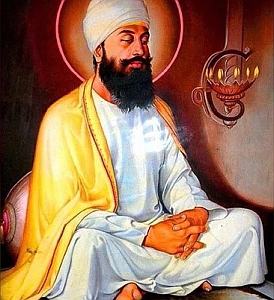 Guru Tegh Bahadur is the 9th Guru of Sikhism, and was martyred by the Mughal Emperor Aurangazeb. He was son of Guru Hargobind, and was a holy and spiritually inclined person right from childhood. Originally born and name as Tyagmal, his father renamed him as ‘Tegh Bahadur’ – “the Knight of the Sword” for his bravery in battle as a 13-14 year old.
Guru Tegh Bahadur is the 9th Guru of Sikhism, and was martyred by the Mughal Emperor Aurangazeb. He was son of Guru Hargobind, and was a holy and spiritually inclined person right from childhood. Originally born and name as Tyagmal, his father renamed him as ‘Tegh Bahadur’ – “the Knight of the Sword” for his bravery in battle as a 13-14 year old.
GURU TEGH BAHADUR
(1625 – 1675 A.D.)
There was a search for the true (spiritual) heir and successor to the Guruhood when the Sikh Guru Harkishen passed away suddenly at Delhi when he was on a visit over there, on an invitation from the Mughal Emperor Aurangazeb for some discussions and negotiations. It is said, the last words uttered by Guru Harkishen before his death were “Baba Bakale” – which seemed to imply, “my successor (the next Guru) is at Bakala”.
As no name was specified by the deceased Guru as to who was to succeed him, many claimants from his kith and kin and also outsiders proclaimed themselves as the next Guru. There were about 21 of them making aggressive claims. Besides these twenty one, there was also the humble, unassuming, most pious Tegh Bahadur, but who was mostly lost in his own contemplation, also being sought by many to take over the Guruhood. He was the fifth son of one of the earlier Gurus. Guru Har Gobind, the sixth of the Sikh Gurus. The seventh Guru was Har Rai, a nephew of Tegh Bahadur and the eighth one was Guru Harkishen, the son of Guru Har Rai.
There was utter confusion in the Sikh community as to whom they should follow as their Guru. How to decide who is the true successor for the exalted position ?
 Just during the period of this uncertainty, one Makhan Shah, a rich trader and who was unaware of these happenings and even of the death of Guru Harkishen, was on a trade-voyage on the foreign seas. On the voyage his ship was suddenly caught in a big storm and was on the verge of sinking. Makhan Shah prayed to the Guru, “Oh Guru! if you save my ship and our lives, I wi1l offer you 500 gold mohurs”. Miraculously, the storm weakened down and the ship was saved. As he reached back, safely to the Indian shores, he rushed to Bakala. He came to know of the passing away of Guru Harkishen and the confusion regarding his successor to the Guruhood. He was anxious to discharge this pledge of the gold mohurs. He thought of a plan to find out who is the true Guru. He went to each of the claimants and was offering them one Gold mohur for having saved his ship in the storm. Every one of them was gladly accepting it and patting him for his devotion. His last offer was to Guru Tegh Bahadur who instantly said, “Where are the rest of the 499 Gold mohurs you vowed to offer to the Guru when you were in peril? You vowed to offer 500 gold mohurs. not just one mohur?”
Just during the period of this uncertainty, one Makhan Shah, a rich trader and who was unaware of these happenings and even of the death of Guru Harkishen, was on a trade-voyage on the foreign seas. On the voyage his ship was suddenly caught in a big storm and was on the verge of sinking. Makhan Shah prayed to the Guru, “Oh Guru! if you save my ship and our lives, I wi1l offer you 500 gold mohurs”. Miraculously, the storm weakened down and the ship was saved. As he reached back, safely to the Indian shores, he rushed to Bakala. He came to know of the passing away of Guru Harkishen and the confusion regarding his successor to the Guruhood. He was anxious to discharge this pledge of the gold mohurs. He thought of a plan to find out who is the true Guru. He went to each of the claimants and was offering them one Gold mohur for having saved his ship in the storm. Every one of them was gladly accepting it and patting him for his devotion. His last offer was to Guru Tegh Bahadur who instantly said, “Where are the rest of the 499 Gold mohurs you vowed to offer to the Guru when you were in peril? You vowed to offer 500 gold mohurs. not just one mohur?”
Makhan Shah was overjoyed that he found the true Guru, offered at his feet the 500 gold mohurs. Thereafter he went on proclaiming to everyone about the incident, how that amongst the twenty two claimants only Tegh Bahadur could divine what he vowed in the far distant place, on the high seas. Thus, Tegh Bahadur came to be accepted as the successor Guru to Guru Harkishen.
His nephew Dhirmal, who was also aspiring for Guruhood, was burning with envy that he lost the Guruhood to Tegh Bahadur. He conspired along with a follower of his, Shihan, to get Tegh Bahadur assassinated. But they were foiled in their attempt and were caught. When Dhirmal was brought before Tegh Bahadur, the latter in compassion, said “Dhirmal! You are my nephew! I bear no ill-will or anger against you whatever harm you tried to do me”. He set them free. When his disciples were still insisting that Dhirmal and his accomplices should be punished, he told them “Forgiveness and returning good for evil is the supreme Sikh Dharma”. His generous and magnanimous nature won the hearts of all, and he thus became established as the 9th Sikh Guru.
Birth and Early Life
It was at dawn, on the 1st April, 1621, that Tegh Bahadur was born to Guru Hargobind and Nanki, in the Holy city of Amritsar. The father named the child as ‘Tyagmal’ and blessing him that he should keep up and live in the spirit of self-sacrifice in his life and prove to be true and worthy to the name “Tyagmal”, he was bestowing on him. The child was most charming.
When Tyagmal was four and half years old the father took him to Bhai Buddha who was his own preceptor in his childhood, and entrusted the child to his care. Tyagmal learnt all sciences and arts and the use of weapons, under the old preceptor’s care. He learnt also music and poetry under him, and three and half years later, he was initiated. He then became intensely interested in spiritual life. He used to listen with rapt attention discourses of his father on religious matters. One of his father’s constant teachings to his disciples made such a deep impact and indelible impression on his heart: which was “that a truly religious man is one who is wise and fearless and has an abiding and unswerving faith in God and is prepared and ready to sacrifice his all and even his life, in the cause of his faith”
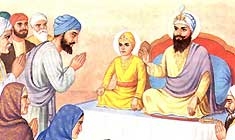 When Tyagmal was eleven years old, he was married to Gujri. When he was hardly 13 – 14 years of age, he fought a battle alongside his father against the Moghal army led by Kale Khan, which attacked the Sikhs. The enemy suffered a crushing defeat. The young Tyagmal fought in the battle like a lion, and in recognition and appreciation of his valour, the father renamed him as ‘Tegh Bahadur’ – “the Knight of the Sword”. Guru Har Gobind passed away in 1644 at Kartarpur. Before his death, he appointed Har Rai as his successor. Har Rai was the grandson of Har Gobind, and a nephew of Tegh Bahadur. Tegh Bahadur set out from Amritsar with his mother Nanki and his wife Gujri to settle in the village of Bakala, to pursue his spiritual life. For twenty years he lived at Bakala doing penance and intense meditation.
When Tyagmal was eleven years old, he was married to Gujri. When he was hardly 13 – 14 years of age, he fought a battle alongside his father against the Moghal army led by Kale Khan, which attacked the Sikhs. The enemy suffered a crushing defeat. The young Tyagmal fought in the battle like a lion, and in recognition and appreciation of his valour, the father renamed him as ‘Tegh Bahadur’ – “the Knight of the Sword”. Guru Har Gobind passed away in 1644 at Kartarpur. Before his death, he appointed Har Rai as his successor. Har Rai was the grandson of Har Gobind, and a nephew of Tegh Bahadur. Tegh Bahadur set out from Amritsar with his mother Nanki and his wife Gujri to settle in the village of Bakala, to pursue his spiritual life. For twenty years he lived at Bakala doing penance and intense meditation.
Meanwhile, at Kartarpur, Guru Har Rai died. His son Har Kishen succeeded as the next Guru. Emperor Aurangazeb invited Har Kishen to Delhi for some discussions and negotiations. At Delhi Har Kishen passed away suddenly, uttering as his last words “Baba Bakale”.
Becomes 9th Guru
After becoming the Sikh Guru, Tegh Bahadur visited Amritsar and prayed at the Har Mandir, which was built by his grandfather. Once as he was passing through Rupar, the Nawab of Saifabad and his Begum prayed to him to be their guest. The Guru stayed for a fortnight there and when he was leaving, the Nawab gave him many gifts of horses, camels, many vessels, etc. The Guru accepted the horses and a few camels, and utensils for the langar — the comunity kitchen. From there he visited Varanasi. When his disciples said they would like to go for the Holy bath in the sacred Ganges, the Guru said “Dig in this room, the Holy waters will stream forth here itself”. The Holy Ganges waters did stream forth there. The Guru told them, “You have to keep your heart always as pure as the Ganges waters”.
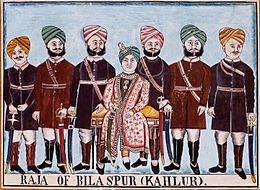 The Guru visited Kartarpur, the seat of the earlier Guru and wanted to settle there. But as Dhirmal and others continued to evince their animosity towards him and did not allow him to live in peace, he left Kartarpur. He obtained a piece of land near Makhewal from the King of Kahlur. He built a township there and named it Anandpur. Here also, he was not allowed to live in peace by Dhirmal and his accomplices. His enemies continued their intrigues against him and colluded with Aurangazeb, and many charges were framed against him, especially treason against the Moghal rule. The Rajah of Jaipur pleaded with Aurangazeb that the Guru Tegh Bahadur had no political ambitions except religious and spiritual zeal. This calmed the situation to some extent. The Rajah of Jaipur had advised the Guru, that he had better go elsewhere for some time for his own safety and he said he would also accompany ‘him. He proposed that they visit Assam. As they reached Patna on their journey, his wife reached the time of confinement. Therefore, he had to leave her there with his relations. He then proceeded further. When he was at Dacca. he received the news of his having been blessed with a son, later named Gobind Singh.
The Guru visited Kartarpur, the seat of the earlier Guru and wanted to settle there. But as Dhirmal and others continued to evince their animosity towards him and did not allow him to live in peace, he left Kartarpur. He obtained a piece of land near Makhewal from the King of Kahlur. He built a township there and named it Anandpur. Here also, he was not allowed to live in peace by Dhirmal and his accomplices. His enemies continued their intrigues against him and colluded with Aurangazeb, and many charges were framed against him, especially treason against the Moghal rule. The Rajah of Jaipur pleaded with Aurangazeb that the Guru Tegh Bahadur had no political ambitions except religious and spiritual zeal. This calmed the situation to some extent. The Rajah of Jaipur had advised the Guru, that he had better go elsewhere for some time for his own safety and he said he would also accompany ‘him. He proposed that they visit Assam. As they reached Patna on their journey, his wife reached the time of confinement. Therefore, he had to leave her there with his relations. He then proceeded further. When he was at Dacca. he received the news of his having been blessed with a son, later named Gobind Singh.
For 2 years, Tegh Bahadur stayed in Assam, at the invitation of Rajah Ram Singh. There were some witches of the Ahom tribe, who were troubling the Rajah with their witchcraft. They had created a lot of havoc. The Guru with his spiritual power and prayer overcame their sorcery and saved the King. He warned the witches, that they should not indulge any further in evil practices and waste their lives. He brought in peace between the chief of Ahom and the Rajah Ram Singh. The witches were forgiven. The Guru now returned to Patna and joined his family. From there he came back to Punjab along with his family and started staying at Anandpur. He started devoting his whole time to preaching work, and in uniting all in religious harmony. Many became his followers including large number of Muslims and Pathans.
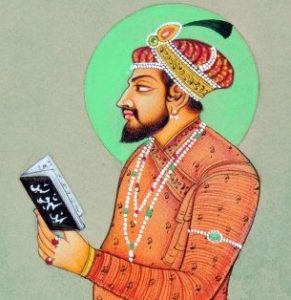 The religious persecution of Aurangazeb came to the Guru and requested he should take up crossing all bounds. The Guru wrote to Aurangazeb that he should not encroach on the Religious Freedom of the people. He said it is against the principle of any religion. Every community should have the right and freedom to practise its religion and live freely according to their faith. He further said that he was prepared to come and meet Aurangazeb to argue and convince him in the matter.
The religious persecution of Aurangazeb came to the Guru and requested he should take up crossing all bounds. The Guru wrote to Aurangazeb that he should not encroach on the Religious Freedom of the people. He said it is against the principle of any religion. Every community should have the right and freedom to practise its religion and live freely according to their faith. He further said that he was prepared to come and meet Aurangazeb to argue and convince him in the matter.
Aurangazeb sent word that the Guru can come and talk to him. This was only a ruse. When the Guru came in all good faith, Aurangazeb got him locked up in the Chandni Chowk Kotwali. Aurangazeb threatened him that unless he embraced Islam he would be put to death along with his disciples. The Guru stood firm, arguing that it is wrong to impose one’s religion on those who believe differently. He said he cared little for his life and would never sacrifice his principles.
Aurangazeb tried all means to convert the Guru to Islam. He tried to frighten him into submission. Before the Guru’s very eyes, he got his disciples Bhai Mati Das and Bhai Dayala and Bhai Sati Das put to torture and death. All of them died with a smile on their face. As the Guru did not yield even with all this, he was beheaded. Bhai Jetha stole the head of the Guru. Lakhi Shah, the Banjara, managed to rescue the body of the Guru and carried it to his house and set fire to the house, to cremate the Holy body of the Guru. Bhai Jetha carried the head and delivered it at Kartarpur, to the Guru’s son Gobind Rai and his mother. The head of the Guru was carried in a palanquin to Anandpur and was cremated there.
The Guru showed by his peerless example what he learnt as a child from his father that a truly religious man is he who is wise and fearless and cherishes an abiding faith in God, and with a will to sacrifice his all for his Faith.
By sacrificing his own life, dying a martyr, Guru Tegh Bahadur made his Sikh Faith eternal and immortal.
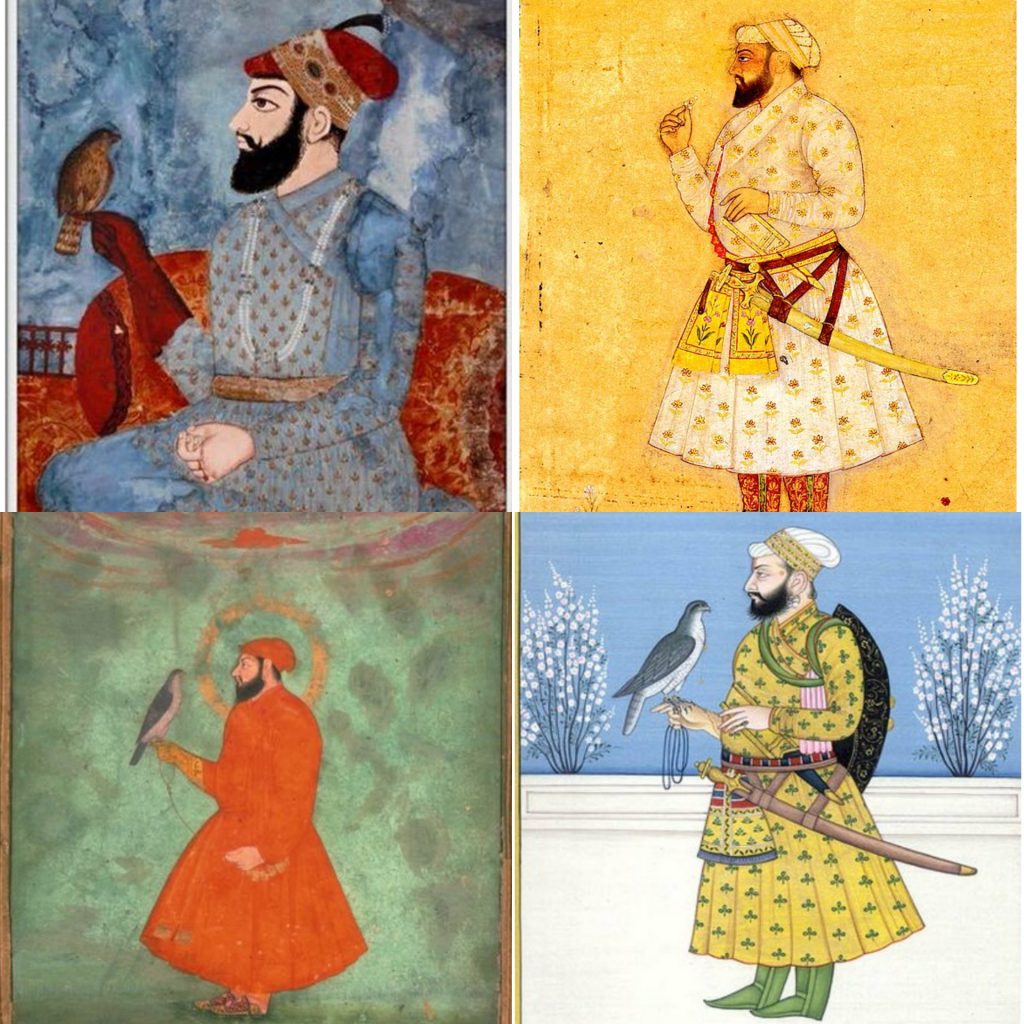
![]()

